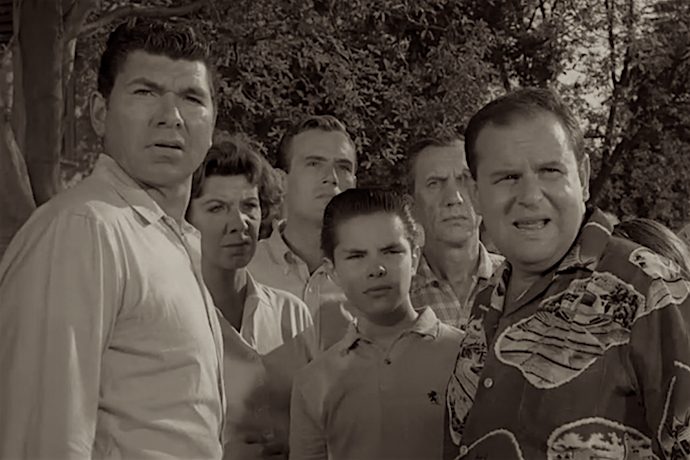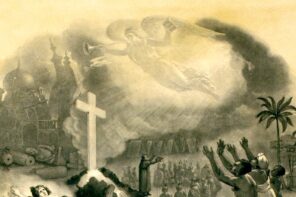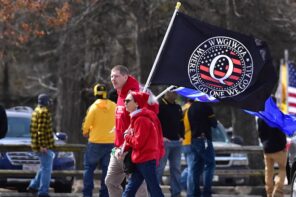The mainstream discourse in the West describes the “War on Terror” as a “geopolitical” mission. When we speak of terrorism, we talk about territories held and lost by “extremists” and “insurgents,” the challenge of migrations and home-grown terror networks, subnational identities and the ideological struggle for hearts and minds at home. But in conceiving terrorism as geopolitics, the discourse of a “War on Terror” typically neglects the psychological toll that accompanies every war: the post-traumatic stress that seizes up in societies that are chronically beset—either by war and terrorist violence, or by state counter-insurgency, domestic security, and counter-terrorism programming.
If terrorism is geopolitical, it’s because it damages psyches as much as bodies. In emphasizing the geopolitical aspect of its “War on Terror,” has the West missed the fact that it has been colonized by a psychic terrorism—one inspired as much by the hypervigilant paranoia of homeland security and law enforcement as by any actual terrorist activity?
This is the hypothesis I have grappled with after my experience earlier this month at John F. Kennedy International Airport in New York, as I waited to board a flight back home to Oslo. I was there on Aug. 14, 2016, when, after years of the “War on Terror,” one of North America’s most important international airports seized up as panicked reports of “multiple active shooters”—later discredited as false—swept through the terminals, sending passengers, law-enforcement, and airline workers scrambling for cover and eventually onto the tarmac. The responding authorities found neither shooters nor evidence of any shots fired. The most likely explanation offered for the panic was that the cheering of Olympics fans for Usain Bolt’s performance in the 100 meters sounded like gunfire.
In an episode titled “The Monsters are Due on Maple Street,” from the The Twilight Zone‘s first season, aliens discover that they can conquer Earth most easily by using flickering lights to infuse paranoia and fear in its human inhabitants. They found that communities thus charged would turn on each other and the human race would self-destruct.
Since 2001, when Homeland Security began to impose “threat levels” that legitimized the increase in surveillance and control after 9/11, we’ve become used to (and yet also entirely unprepared for) moments of fear and terror. Being frequently put on notice for potential terrorist activity now feels normal, but under the surface of normality hides a heightened sense of insecurity, of fraying bonds of trust.
I was at Gate 4 in JFK’s Terminal 1 when a wave of people suddenly rushed in from the direction of the security checkpoint and duty-free shops. Like an enormous breaker at the beach, the crowd threatened to sweep up virtually everybody in the terminal. I was first stunned, then joined others in crouching between the benches. I waited there until an official-looking man in plain clothes told us to empty the terminal. People began running in panic, dropping their belongings as they ran. We went down a staircase and waited outside for a while, before we got herded to the other side of the terminal where many were already gathered. Clueless as to the situation, with no clear instructions, we stood there, left to ourselves.
In the days after the event, I watched a YouTube video which showed airport police heavily armed in riot gear coming into what looks like JFK’s Terminal 8 to do a sweep. I was reminded of the insistence, by Black Lives Matter activists, that effective policing has to be more than police in riot gear rushing in with big guns—that it’s about being present, building trust, soothing people’s nerves, rather than leaving them exposed to terror or the fear of terror.
Becoming frustrated at the lack of information from uniformed personnel, I went online and asked my friends on social media if they had heard what was going on. Answers came quickly and soon we knew that there were no confirmed shots and that it seemed to have been a false alarm. I shared what I learned with those standing around me or who didn’t have a phone, compared notes with others about what they knew, and tried to calm some who were scared and close to panic.
As far as I could tell, the TSA personnel and other security officials seemed know about as much as the passengers about what was happening—all around me, I sensed a complete failure of nerve. A black woman wearing a security vest crouched outside on the tarmac hiding, behind a luggage container, sobbing uncontrollably. Why was I the only one reaching out to her? I tapped her on her shoulder and said “Give me a hug.” She clung to me for a long while, before I let her go.
What I remember most from growing up during the Cold War in West Germany is how it felt to have “No Future” because the US and Russia had overwhelming arsenals of atomic warheads pointed at each other. From my point of view, the world seems safer now in some ways, and so much less safe in others.
Still, it is we who must make some decisions about how we deal with such a heightened level of anxiety. Authoritarian forces in governments all over the world can stoke our anxiety in order to justify more control. They can fake a coup, botch the response to an attack, and push through “heightened security measures.” So much of the militarized response to terror seems to feed upon terror and feed it back into the populace.
So I decided that JFK would not be a site of terror for me, but one of encounter.
What can equip us to deal more productively with the vagaries of catastrophe, of emergency, and how can we be more resilient in the face of contingency and the fragility of life?
There is no fear in love, but perfect love casts out fear; for fear has to do with punishment, and whoever fears has not reached perfection in love.
—1 John 4:18
“There is no fear in love.” That really says it for me, each time. Is my basic life stance fear, or is it love? When the empire chooses fear, and feeds on it, what will it take to choose love, personally, and collectively?
That Twilight Zone episode mentioned above ends with the following epilogue:
The tools of conquest do not necessarily come with bombs and explosions and fallout. There are weapons that are simply thoughts, attitudes, prejudices—to be found only in the minds of men. For the record, prejudices can kill and suspicion can destroy, and a thoughtless, frightened search for a scapegoat has a fallout all its own—for the children and the children yet unborn.
Might we, too, cause our own self-destruction because we buy into the fear and xenophobia infesting governments on both sides of the ocean?
Airports are places where I feel my boundaries open to expansion, not contraction, because that is how I choose to encounter my fellow humans, and if necessary, death. For death is inevitable, anyway—in case we’ve forgotten. And I would rather meet it in love, and not in fear.
* The author wishes to thank Jorge Aquino, Associate Professor in the Department of Theology and Religious Studies at the University of San Francisco, for reviewing an earlier draft and providing valuable commentary.





